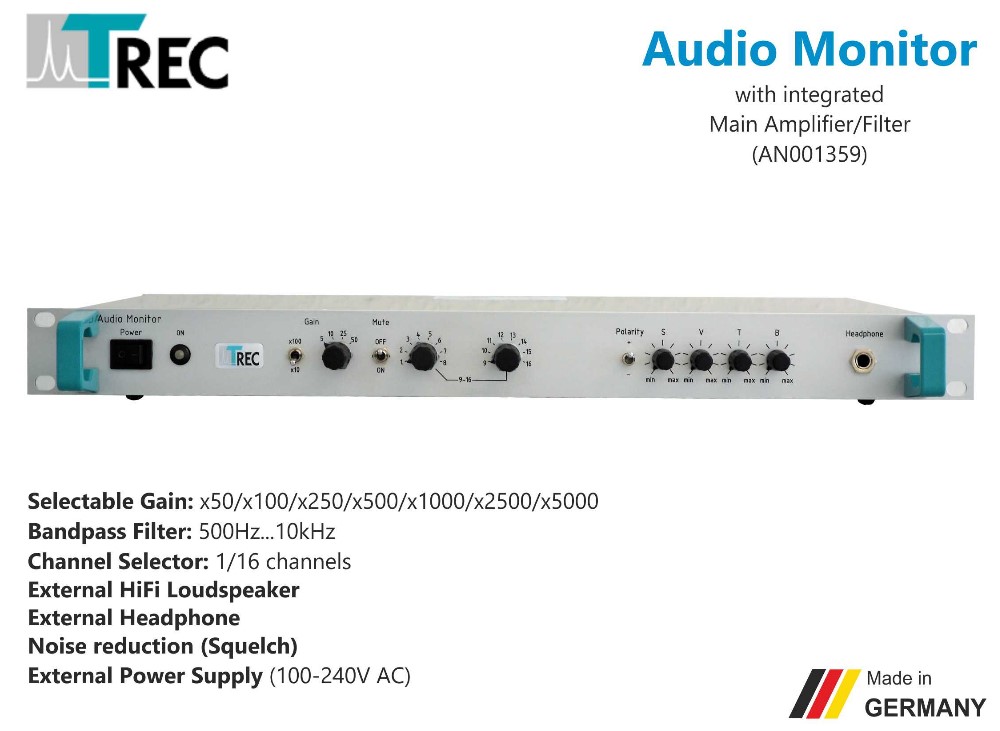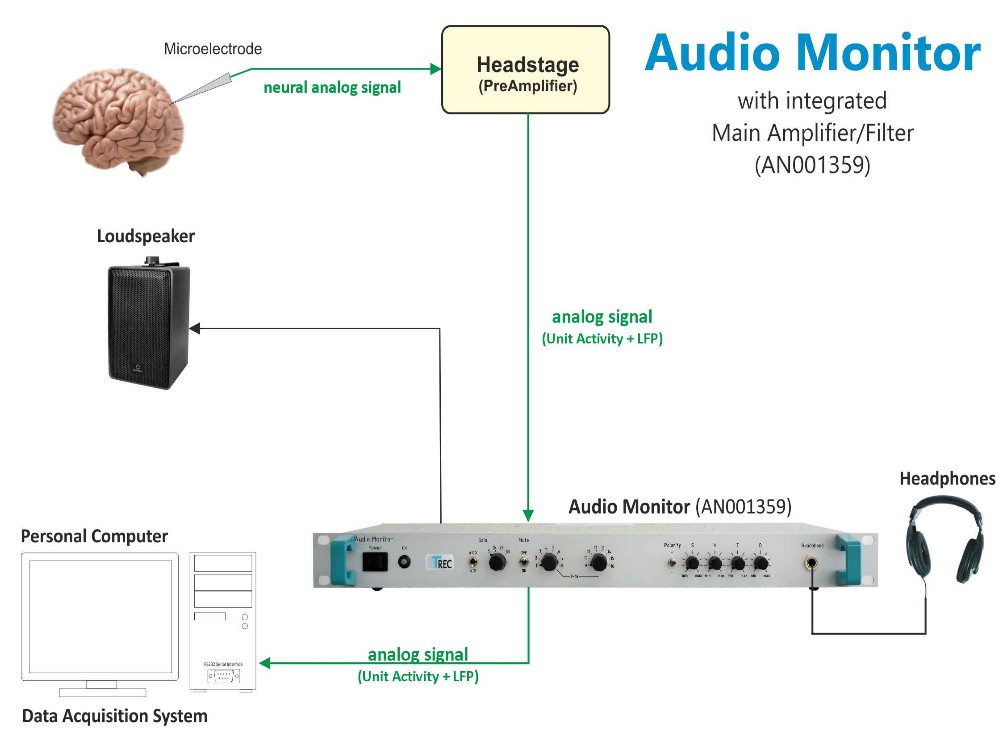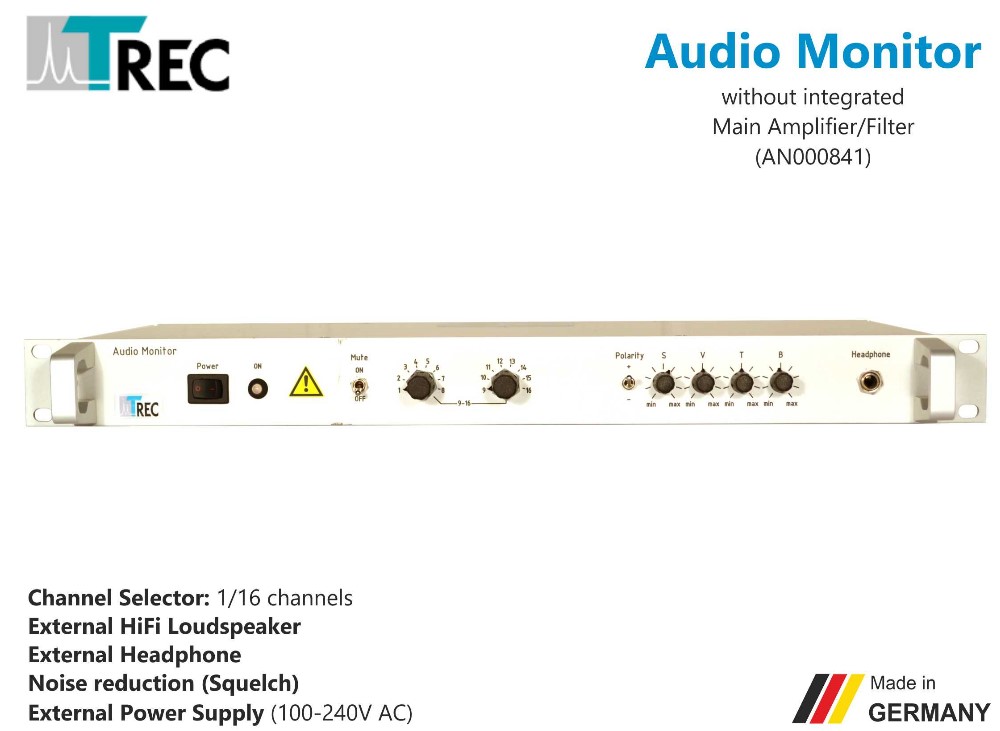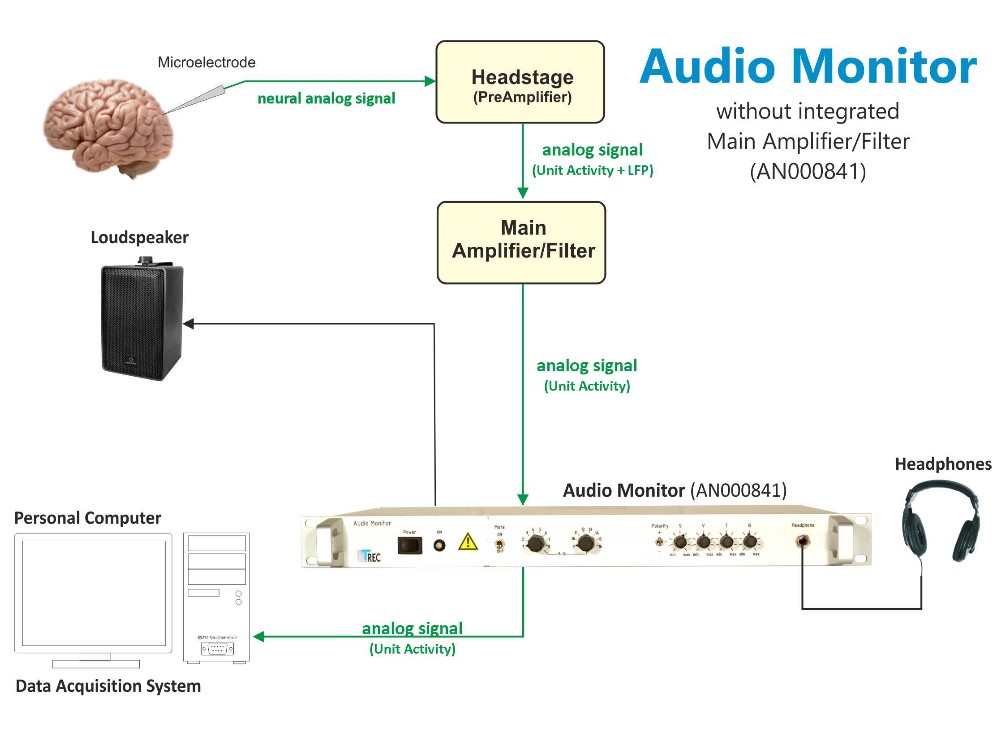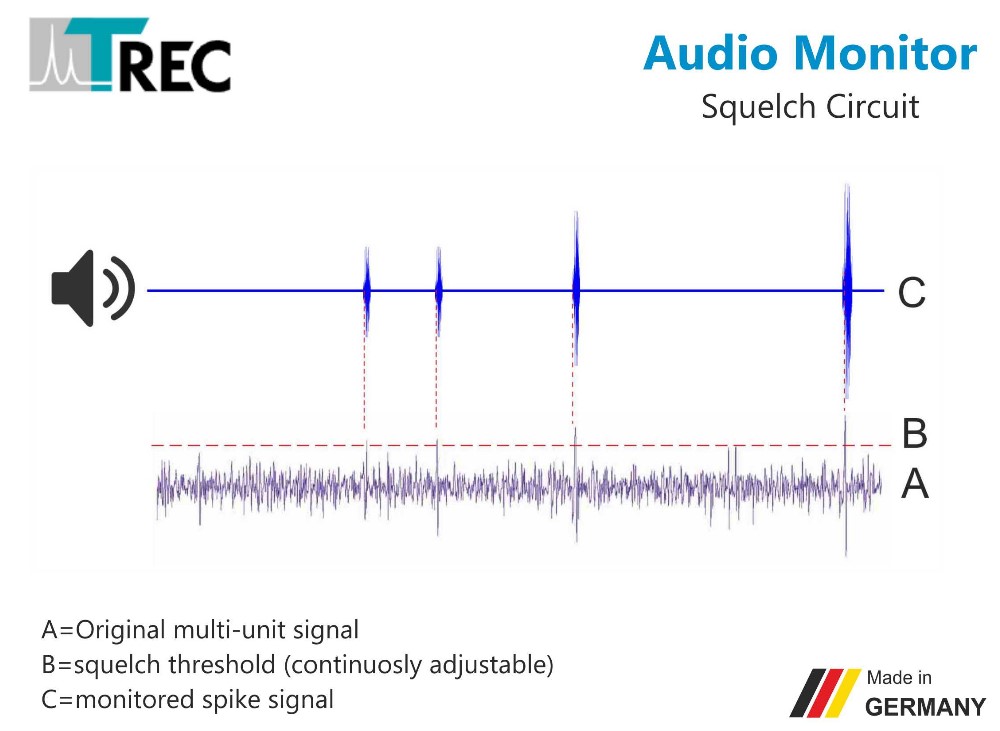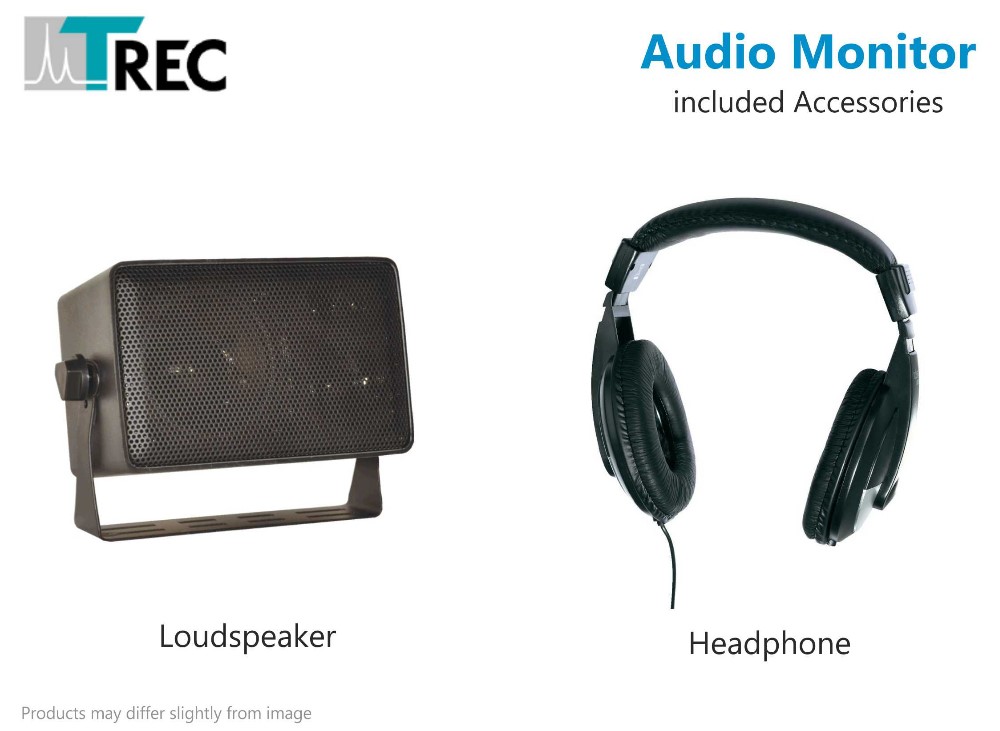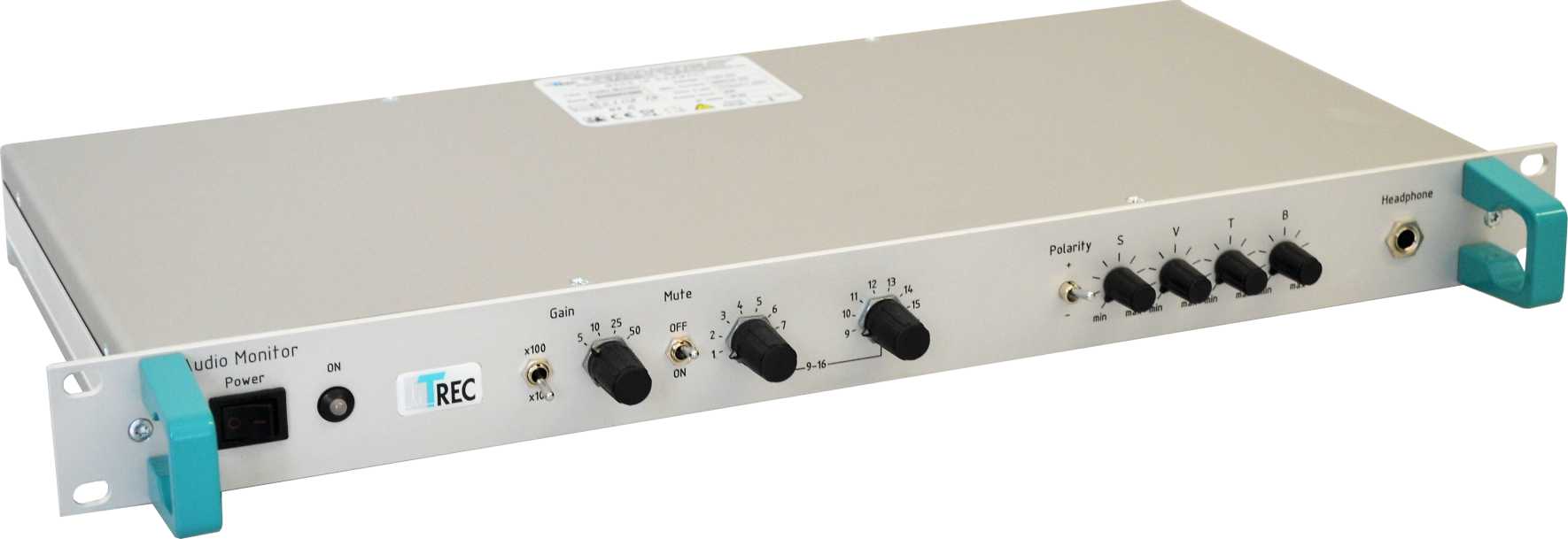Audio Monitor
Audio Monitor
When monitoring neurophysiological data, experimenters need not be limited to their sense of sight. The data may also be monitored with great sensitivity using the sense of hearing. In such cases, the data are input to an audio monitor and fed to a loudspeaker or a set of headphones. Our ears have evolved to detect subtle patterns of sounds. Neurophysiologists exploit this capability by listening to the electrical signals recorded from the nervous system. Individual action potentials are heard as a popping sound. Simultaneous action potentials from multiple neurons are heard as a whoosh sound. The TREC AUDIO MONITOR is a power amplifier that applies the signal coming from the electrode directly to the speaker or headphones without any delay by data acquisition systems, thereby allowing signals in the audio bandwidth to be heard. We offer two different versions of our audio monitor: AN000841 has no integrated main amplifier and is connected to the analog signal output of a neural signal bandpass main amplifier. AN001359 has an integrated bandpass main amplifier and is connected to the headstage (preamplifier) analog signal output.
Key features:
- Monitor channel selection button for 1- out of 16 channels
- Available with and without integrated main bandpass amplifier
- Audio ON/OFF
- High quality loudspeaker (included)
- Headphonses jack
- High quality headphones (included)
- Rackmountable 19″ cabinet
- Ext. power supply 90-264V AC
- volume control
- Noise Threshold control (squelch)
- Equalizer control (bass, treble)
| Dimensions and Weight | |
| Length (mm) | 485 mm |
| Width (mm) | 250 mm |
| Height (mm) | 45 mm |
| Weight (kg) | 2 kg |
| Power Supply | |
| Mains supply voltage (V) | 90-264V AC / 47-63Hz (ext. Power Supply) |
| Power consumption (W): | 5W |
| Signal Input | |
| Number of channels: | 1 out of 16 Unfiltered analog neural signal from headstage/preamplifier |
| Input connector: | 25pin DSUB (male) |
| Bandpass filter/Amplifier | |
| Gain: | x50/x100/x250/x500/x1000/x2500/x5000 |
| Bandpass: | 500Hz…10kHz |
| Signal Output | |
| Equipment: | Loadspeaker and headphones (included) |
| Output connector: | 25pin DSUB (female) |
| Article | |
| Articel number: | AN001359 |
| Dimensions and Weight | |
| Length (mm) | 485 mm |
| Width (mm) | 250 mm |
| Height (mm) | 45 mm |
| Weight (kg) | 2 kg |
| Power Supply | |
| Mains supply voltage (V) | 90-264V AC / 47-63Hz (ext. Power Supply) |
| Power consumption (W): | 5W |
| Signal Input | |
| Number of channels: | 1 out of 16 Main amplified and bandpass filtered analog neural signal from analog signal output of main amplifier |
| Input connector: | 25pin DSUB (male) |
| Signal Output | |
| Equipment: | Loadspeaker and headphones (included) |
| Output connector: | 25pin DSUB (female) |
| Article | |
| Articel number: | AN000841 |
The TREC AUDIO MONITOR is available in two different versions: with and without integrated bandpass main amplifier filter (see figures 1 and 2).
Figure 1: TREC audio monitor with integrated bandpass main amplifier filter with selectable gain (x50…x5000) and fixed bandpass filter (500Hz…10kHz). This audio monitor is connected to the analog headstage/preamplifier signal output.

Figure 2: TREC audio monitor without integrated bandpass main amplifier filter to be connected to an analog main amplifier signal output.
Both versions of the TREC audio monitors offer advanced audio features like a noise suppression circuit that allows background noise reduction (e.g. reducing neural background noise while improving the quality of single unit sound).
Figure 3: Working principle of the squelch. (A) original spike signal, (B) squelch level selected with squelch control at the audio monitor front panel, (C) resulting discriminated signal in the loudspeaker. Low amplitude background hiss is removed.
Please find an audio file below that demonstrates the signal from the audio monitor loudspeaker. The audio file starts with the multi unit signal, then the threshold for the squelch is increased slowly to isolate the single units and to reduce the neural background noise. At the end of the audio file the threshold is reduced again to get the multi unit activity.
This type of audio monitor is frequently used in central nervous system recording. Each spike is heard as an audible click, and the rate and volume of clicking is a good indicator of nerve cell activity.
One use for the TREC AUDIO MONITOR is to listen to the neural signals while stimulating the neurons you can easily determine whether some sounds are correlated to your stimulation. You can then look at the oscilloscope to see whether you can pinpoint the features in the signal that correspond to the sounds you heard thus identifying the relevant activity within the recording.
Use the volume, bass, and treble controls on the AUDIO MONITOR to adjust the signal level and sound quality; these controls only affect the speakers and will have no effect on the signal that is recorded by the computer. Both speakers of the headphones will deliver the same sound. The Instrument is not intended for clinical measurements using human subjects.
Audio monitors are standard features in TREC neuroscience recording systems. To minimize the potential for aggravation, we include a headphone jack so that users can listen to the audio output without testing the patience of their colleagues.
Once electrodes are in place and the amplifier is turned on and in REC mode, spontaneous action potentials should be evident as fast deflections on the oscilloscope. You should also be hearing ‘pops and crackles’ coming from the audio monitors.
Questions? Please don’t hesitate contacting us!

NEWS

PRODUCTS

SOLUTIONS

DISTRIBUTORS
SIGN UP TO OUR NEWSLETTER
 Sign Up
Sign Up
